Table of Contents
Calisthenics in the 1950s was a popular way to get fit and stay healthy. It was a time when people were looking for ways to improve their physical fitness without having to go to the gym. Calisthenics provided a convenient and effective way to do just that. On Kizworld, we will explore the history of calisthenics in the 1950s, and provide tips on how you can incorporate calisthenics into your own fitness routine.
The Calisthenics Revolution in the 1950s: Transforming Bodies and Lives
Year | Event |
|---|---|
1942 | The U.S. Army publishes "Physical Fitness Training Manual FM 21-20," which includes calisthenics exercises. |
1952 | Jack LaLanne opens his first health club in Oakland, California, and popularizes calisthenics through his TV show. |
1953 | The first issue of "Muscle Builder" magazine is published, featuring articles on calisthenics and other fitness topics. |
1955 | The film "Rebel Without a Cause" features a scene where James Dean performs a pull-up, showcasing the popularity of calisthenics among youth. |
1956 | The U.S. Air Force Academy adopts calisthenics as part of its physical training program. |
I. Calisthenics in the 1950s: A Golden Era
The Rise of Calisthenics in Post-War America
The 1950s marked a golden era for calisthenics, a form of exercise that uses bodyweight movements to build strength, flexibility, and endurance. Calisthenics had been around for centuries, but it gained widespread popularity in the post-war era due to several factors, including the rise of the fitness craze, the influence of popular culture, and the growing availability of fitness resources.
After World War II, there was a growing interest in health and fitness among Americans. People were eager to get in shape and improve their overall well-being. Calisthenics was seen as an accessible and effective way to achieve these goals. It was simple to learn, required no special equipment, and could be done anywhere.
- How to Do a Muscle Up
- The Best Calisthenics Gifts and Accessories
- The Best Calisthenics Quotes and Motivation
The Legacy of Calisthenics in the 1950s
The popularity of calisthenics in the 1950s had a lasting impact on the fitness landscape. Calisthenics exercises became a staple of physical education programs in schools and fitness centers. They were also featured in popular fitness magazines and books, such as "Muscle Builder" and "Strength & Health."
The legacy of calisthenics in the 1950s can still be seen today. Calisthenics exercises are still widely used in fitness programs around the world. They are also popular among athletes, martial artists, and military personnel.
Year | Event |
|---|---|
1942 | The U.S. Army publishes "Physical Fitness Training Manual FM 21-20," which includes calisthenics exercises. |
1952 | Jack LaLanne opens his first health club in Oakland, California, and popularizes calisthenics through his TV show. |
1953 | The first issue of "Muscle Builder" magazine is published, featuring articles on calisthenics and other fitness topics. |
Calisthenics in the 1950s: A Golden Era
II. The Rise of Calisthenics in Post-War America
Calisthenics and Post-WWII Fitness Revival
In the aftermath of World War II, the United States experienced a surge in interest in physical fitness. This was due in part to the war itself: the mobilization of millions of men and women into the armed services led to a renewed focus on physical training and conditioning.
Post-war America also saw a rise in the popularity of new fitness activities, such as aerobics and weightlifting. However, calisthenics remained a popular choice for many people, as it was a simple, inexpensive, and effective way to get in shape.
The Role of the Military
The US military played a major role in the popularization of calisthenics in the 1950s. In 1942, the US Army published "Physical Fitness Training Manual FM 21-20," which included calisthenics exercises. This manual was widely distributed to soldiers, and it helped to standardize calisthenics training across the armed forces.
The US Air Force also adopted calisthenics as part of its physical training program in 1956. This helped to further popularize calisthenics among young men and women.
The Fitness Craze of the 1950s
The 1950s was a time of great change in the United States. The country was experiencing a period of economic prosperity, and the baby boom generation was coming of age. These factors led to a surge in interest in fitness and recreation.
Calisthenics | Benefits |
|---|---|
Push-ups | Chest, shoulders, triceps |
Pull-ups | Back, biceps, forearms |
Squats | Legs, glutes, core |
Calisthenics was one of the most popular fitness activities of the 1950s. This was due in part to the fact that it was a simple and effective way to get in shape. It was also relatively inexpensive, and it could be done anywhere. As a result, calisthenics became a popular activity for people of all ages and backgrounds.
III. Calisthenics and the Fitness Craze of the 1950s
The Influence of Jack LaLanne
One of the most influential figures in the calisthenics movement of the 1950s was Jack LaLanne. LaLanne was a fitness guru who promoted the benefits of exercise and nutrition. He opened his first health club in Oakland, California in 1952, and he quickly became a national celebrity.
LaLanne's TV show, "The Jack LaLanne Show," aired from 1953 to 1985. The show featured LaLanne performing calisthenics exercises and promoting healthy living. LaLanne's show was very popular, and it helped to inspire millions of Americans to get in shape.
The Rise of Calisthenics Magazines
The 1950s also saw the rise of calisthenics magazines. These magazines featured articles on calisthenics exercises, nutrition, and fitness. They were very popular with people who were interested in getting in shape.
One of the most popular calisthenics magazines of the era was "Muscle Builder" magazine. The first issue of "Muscle Builder" was published in 1953, and it quickly became one of the best-selling fitness magazines in the country.
- 1942: The U.S. Army publishes "Physical Fitness Training Manual FM 21-20," which includes calisthenics exercises.
- 1952: Jack LaLanne opens his first health club in Oakland, California, and popularizes calisthenics through his TV show.
- 1953: The first issue of "Muscle Builder" magazine is published, featuring articles on calisthenics and other fitness topics.
- 1955: The film "Rebel Without a Cause" features a scene where James Dean performs a pull-up, showcasing the popularity of calisthenics among youth.
- 1956: The U.S. Air Force Academy adopts calisthenics as part of its physical training program.
The Rise of Calisthenics in Post-War America
IV. Calisthenics and the Fitness Craze of the 1950s
The Rise of Home Exercise
The post-war period saw a rise in home exercise as people sought ways to stay fit without having to go to the gym. Calisthenics, with its simple exercises and no need for special equipment, was a perfect fit for this trend. Magazines such as "Muscle Builder" provided workouts and tips that could be done at home.Read more about how to get started with calisthenics as a beginner: How to get started with calisthenics as a beginner
The Influence of Jack LaLanne
Jack LaLanne was a major figure in the fitness movement of the 1950s. He opened his first health club in Oakland, California, in 1952 and popularized calisthenics through his TV show. LaLanne's enthusiasm and charisma helped to make calisthenics more mainstream, and he inspired many people to adopt this form of exercise.Read more about the best calisthenics equipment and gear: The best calisthenics equipment and gear
The Fitness Craze
The fitness craze of the 1950s was fueled by a number of factors, including the post-war economic boom, the rise of leisure time, and the growing awareness of the importance of health. Calisthenics played a major role in this craze, as it was a convenient and effective way to get fit.
Year | Event |
|---|---|
1942 | The U.S. Army publishes "Physical Fitness Training Manual FM 21-20," which includes calisthenics exercises. |
1952 | Jack LaLanne opens his first health club in Oakland, California, and popularizes calisthenics through his TV show. |
1953 | The first issue of "Muscle Builder" magazine is published, featuring articles on calisthenics and other fitness topics. |
1955 | The film "Rebel Without a Cause" features a scene where James Dean performs a pull-up, showcasing the popularity of calisthenics among youth. |
1956 | The U.S. Air Force Academy adopts calisthenics as part of its physical training program. |
Calisthenics and the Fitness Craze of the 1950s
V. The Legacy of Calisthenics in the 1950s
The legacy of calisthenics in the 1950s is undeniable. Calisthenics helped to shape the fitness landscape of the era and continues to be popular today. Here are some of the ways that calisthenics has left a lasting impact:
- **Calisthenics helped to popularize fitness.** Before the 1950s, fitness was not as widespread as it is today. Calisthenics helped to make fitness more accessible and appealing to people of all ages and fitness levels.
- **Calisthenics helped to promote bodyweight training.** Bodyweight training is a great way to get in shape without having to use weights. Calisthenics exercises can be done anywhere, which makes them a convenient option for people who don't have access to a gym.
- **Calisthenics helped to lay the foundation for modern fitness trends.** Many of the fitness trends that are popular today, such as CrossFit and boot camp classes, incorporate calisthenics exercises. Calisthenics provides a solid foundation for fitness and can help people to achieve their fitness goals.
- The 1950s were a golden era for calisthenics . The rise of calisthenics during this time can be attributed to a number of factors, including:
- The post-war economic boom led to increased leisure time and disposable income, which allowed people to spend more time on fitness and recreation.
- The growing popularity of television and magazines brought calisthenics into the homes of millions of Americans.
- The fitness craze of the 1950s was fueled by a desire to look and feel good.
- The legacy of calisthenics in the 1950s is vast and varied. Its impact on fitness can be still seen today , and it continues to inspire people to get in shape and stay healthy.
VI. The Best Calisthenics Bars and Rings
- Calisthenics is a great way to get in shape, and one of the best ways to do calisthenics is to use a set of calisthenics bars or rings.
Name
Location
Job Title
Alfreds Futterkiste
Germany
Sales Representative
Berglunds snabbköp
Sweden
Sales Representative
Island Trading
UK
Sales Representative
The Legacy of Calisthenics in the 1950s
VII. Conclusion
Calisthenics in the 1950s was a popular way to get fit and stay healthy. It was a time when people were becoming more aware of the importance of exercise, and calisthenics was a great way to get a full-body workout without having to go to a gym. Today, calisthenics is still a popular form of exercise, and it's a great way to improve your strength, flexibility, and endurance. If you're looking for a fun and challenging way to get fit, calisthenics is a great option.